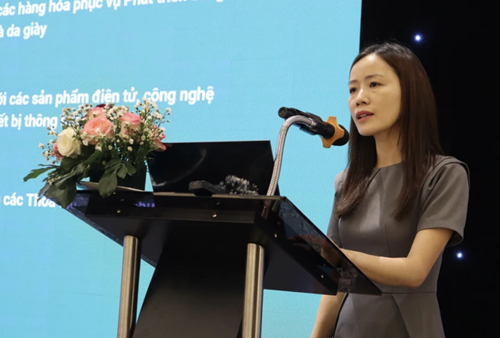The event was co-organized by the MoIT’s department of overseas market development and the municipal international integration center.
Mai Anh noted that the South Asian region, comprising India, Pakistan, Bangladesh, Nepal, Bhutan, Maldives, Sri Lanka, and Afghanistan, has a combined population of over 1.8 billion, accounting for nearly a quarter of the global population. Among these, India, Pakistan, Bangladesh, and Sri Lanka are considered key potential markets for Vietnam to boost trade and investment cooperation.
    |
 |
|
Le Thi Mai Anh from the Ministry of Industry and Trade speaks at the event. |
She said given their large populations and rising incomes, South Asian countries are importing a diverse range of goods including consumer products, processed food, healthcare and beauty items, electronic components, and construction materials. Notably, there is a growing trend among them to diversify sourcing away from China, making Southeast Asia, and Vietnam in particular, a more attractive partner.
However, Mai Anh cautioned that newcomers face steep hurdles, as low average incomes make the markets highly price-sensitive and fiercely competitive. She also pointed to the risk of sudden policy shifts and a growing wave of protectionism across the region.
To succeed in South Asia, Vietnamese businesses should thoroughly research market conditions and partner needs, she said. With Vietnam’s manufacturing strengths, exporters can focus on the growing middle-class and youth-oriented consumer trends, actively join trade fairs, and make use of popular e-commerce platforms in India such as Amazon India, Flipkart, and Daraz.
Assoc. Prof., Dr. Trinh Thi Thu Huong from the Foreign Trade University said logistics remains a key barrier. Apart from India, most South Asian countries face challenges related to poor transport infrastructure, lack of intermodal connectivity, and high shipping costs. Customs procedures are still largely manual, leading to prolonged clearance times, which traders should factor into their planning.
Nevertheless, Huong noted that these challenges also represent opportunities. In markets with easy access, competition tends to be much higher.
Sharing insights from long-term business activities in Bangladesh, Do Van Trong, head of the Vietnamese community liaison board in Bangladesh, said only about 300 Vietnamese enterprises are currently operating in the country, with bilateral trade reaching around 1 billion USD annually.
For new market entry, Trong recommended that businesses consider establishing a direct presence and developing marketing strategies tailored to local tastes and cultural preferences.
Source: VNA